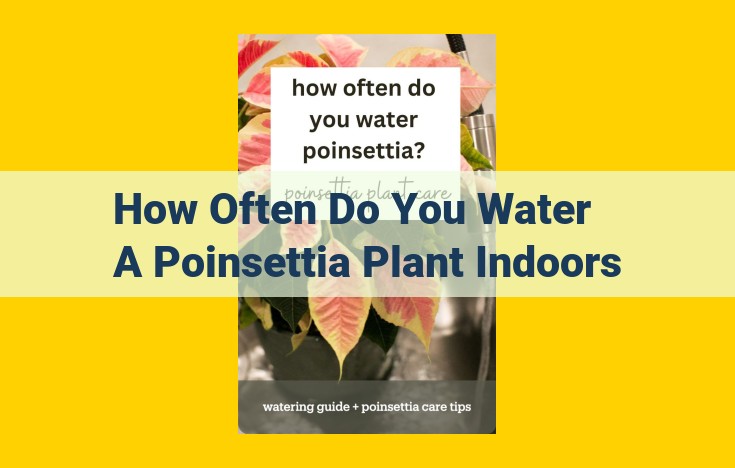To maintain optimal health for indoor poinsettia plants, proper watering is crucial. Check soil moisture regularly and water when the top inch of soil feels dry to the touch. Overwatering should be avoided as it can lead to root rot. Additionally, ensuring adequate humidity by grouping plants together or using a humidifier, as well as providing sufficient light and appropriate temperatures, contribute to a thriving indoor poinsettia environment.
Poinsettia Watering: A Balancing Act
Poinsettias, the vibrant holiday stars, adorn homes and hearts with their captivating crimson hues. However, these festive beauties require a delicate balancing act when it comes to watering. Neglecting their water needs can lead to wilting and despair, while overwatering can invite a watery demise.
Importance of Regular Watering
Like all living beings, poinsettias thrive on a steady supply of water. Regular watering ensures their root system remains hydrated, promoting healthy growth and preventing the telltale signs of thirst, such as drooping leaves and crispy edges.
Determining When to Water
The key to successful poinsettia watering lies in knowing when to quench their thirst. Check the soil moisture by gently inserting your finger about an inch deep. If the soil feels dry to the touch, it’s time to water. Avoid watering on a rigid schedule, as soil conditions and environmental factors can affect the frequency of watering.
Dangers of Overwatering
Overwatering is the cardinal sin of poinsettia care. Waterlogged soil creates an anaerobic environment, depriving roots of oxygen. This can lead to root rot, a devastating condition that can swiftly claim the life of your poinsettia. To avoid this fate, allow the soil to dry out slightly between waterings and ensure your pot has drainage holes to prevent water accumulation.
Environmental Oasis for Poinsettias: Humidity, Light, and Temperature
When it comes to caring for poinsettias, creating an optimal environment is crucial for their well-being and vibrant blooms. Here’s a guide to ensuring your poinsettias thrive in an oasis of comfort:
Humidity Haven: Keeping Leaves Luscious
Poinsettias are moisture-loving plants, and maintaining adequate humidity levels is essential to prevent their leaves from browning and wilting. Aim for humidity levels of around 50-60%. Use a humidifier or place your poinsettia on a tray filled with pebbles and water to increase humidity.
Light & Photosynthesis: Fueling Foliage
Poinsettias require bright, indirect light for optimal growth and photosynthesis. Provide them with 6-8 hours of sunlight each day. However, avoid placing them in direct sunlight, as this can scorch their leaves. East- or west-facing windows are ideal locations.
Temperature Tango: Finding the Sweet Spot
Poinsettias thrive in moderate temperatures between 60-70°F (16-21°C). Drastic temperature fluctuations or exposure to extreme cold can damage their leaves and blooms. Keep them away from drafty areas, doorways, and heating vents.
Additional Care Considerations: Nurturing Your Poinsettias
In addition to the essential elements of watering and environmental control, providing attentive care to your poinsettias ensures their optimal health and vibrant beauty. Here are two crucial aspects to consider:
Fertilizing: Providing Essential Nutrients
Like all living beings, poinsettias require nourishment to thrive. Fertilizing provides them with essential nutrients that support healthy growth and lush foliage. Apply a balanced fertilizer specifically formulated for poinsettias during the active growing season, typically from early spring to late summer. Follow the recommended dosage instructions carefully to avoid over-fertilizing, which can damage the plant.
Root Rot Management: Preventing Waterlogged Conditions
While poinsettias appreciate a moist environment, root rot can be a devastating issue. This condition occurs when the soil remains waterlogged for extended periods, depriving the roots of oxygen. Symptoms of root rot include yellowing or wilting leaves, stunted growth, and a foul odor.
To prevent root rot, ensure the soil has proper drainage. Choose a well-draining potting mix and avoid overwatering. Allow the top inch or two of soil to dry out before watering again. If you suspect root rot, carefully remove the plant from the pot and inspect the roots. Trim away any rotted or discolored roots and repot the plant in fresh, well-draining soil.
